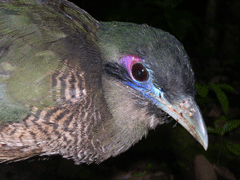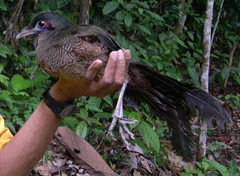Sumatran Cuckoo Breaks Its Silence
Air Date: Week of March 9, 2007
The Sumatran Ground Cuckoo. (Courtesy of Wildlife Conservation Society)
Bruce Gellerman talks with Peter Clyne from the Wildlife Conservation Society about the rare Sumatran Ground Cuckoo bird.
Transcript
GELLERMAN: The devastating earthquake that recently struck Indonesia is only the latest in a long list of disasters to hit the region. In 2004, a tsunami killed hundreds of thousands of people and since then the Asian Archipelago has been plagued with floods, volcanic eruptions, landslides, dengue fever, and bird flu.
But amid all the grim news is one small but noteworthy event: a team of biologists on the island of Sumatra in Indonesia have recorded for the very first time the call of one of the world’s rarest and most secretive birds: the Sumatran Ground Cuckoo.
Joining me is Peter Clyne assistant director of the Asia program at the Wildlife Conservation Society. Hi, Peter.
CLYNE: Hi Bruce.
GELLERMAN: This bird was thought to be extinct in 1916 and then one was found in 1998. How did your scientists come across the Sumatran Ground Cuckoo?

Ground Cuckoo head (Courtesy of Wildlife Conservation Society)
GELLERMAN: So you got the bird.
CLYNE: Yeah, we got the bird. It was early in January of this year. Sure enough basically a hunter from the northern part of Bukit Baresan Selatan National Park called up one of our biologists. His name is Sirdaus Raman and Daus instantly got on a bus and traveled for eight hours to this really remote village and sure enough there it was.
GELLERMAN: And he identified it right away?
CLYNE: Oh yes.
GELLERMAN: It’s very distinctive looking I guess, huh?
CLYNE: It’s very distinctive. It’s about a foot and a half long. It’s got a dark iridescent green back, sort of a rufus red bard underbelly and it’s got a beautiful blue and purple bare patch around the eye. And he spent the night next to the bird with his cell phone recorder in hand hoping to get a recording of the call and that was actually the first recording that we got.

The Sumatran Ground Cuckoo. (Courtesy of Wildlife Conservation Society)
GELLERMAN: Well, I understand we have gotten from you a copy of this call. Let’s listen to it ok?
CLYNE: Ok
[BIRD CALL]
GELLERMAN: Well, that’s not exactly music to my ears.
[BIRD CALL]
CLYNE: I kind of laugh at the song because, ah you know, it’s basically not been known for well 150 years. It finally breaks its silence and it sounds a bit like a chicken running scared or something and that makes me laugh.
GELLERMAN: Why do you want the sounds of the Sumatran Cuckoo in any event?
CLYNE: Well, for a variety of reasons. First because it’s never been noted before, this is of course new information to science which is great. Second we are hopeful that we will be able to use this call to go out into the woods, play it out there, and we hope that other birds will respond to this call. And this is exactly what’s happened with a sister species called the Borneo Ground Cuckoo. Ornithologists went out, used that recording, the birds would respond to that call. So then they got a much better sense for the distribution of the Borneo Ground Cuckoo.
GELLERMAN: Peter, what caused, um this bird to be near extinct?
CLYNE: I think it’s a bit premature to call it nearly extinct. It’s a very very secretive bird and probably a very rare bird. This bird is thought to be found in mountain forests of Sumatra and those are under threat because of conversion to coffee plantations. And this bird may also be found in lowland forests. We’re not sure of that. We’re certainly hoping to find out. The lowland forest of Sumatra is under tremendous threat to conversion to palm oil plantations.
GELLERMAN: Peter before I say bye to you let’s listen to the Sumatran Ground Cuckoo one last time.
[BIRD CALL]
GELLERMAN: Boy that is some sound isn’t it.
CLYNE: It really fills us with a lot of hope and pride actually.
GELLERMAN: Really, why’s that?
CLYNE: Well, you know the Borneo Ground Cuckoo story is a pretty good parallel. And the song really did enable people to go out there and find out quite a bit more about it. And so we’re hopeful that this is going to be the case here too, that there are going to be quite a bit more of the birds than we thought. And hopefully we can show that they’re not actually critically endangered. That’s certainly what we hope so.
GELLERMAN: Peter Clyne is assistant director of the Asia program at the Wildlife Conservation Society, which recorded the song of the rare Sumatran Ground Cuckoo. Peter thank you very much.
CLYNE: Thank you.
Links
Wildlife Conservation Society's website for the Sumatra Ground Cuckoo
Living on Earth wants to hear from you!
Living on Earth
62 Calef Highway, Suite 212
Lee, NH 03861
Telephone: 617-287-4121
E-mail: comments@loe.org
Newsletter [Click here]
Donate to Living on Earth!
Living on Earth is an independent media program and relies entirely on contributions from listeners and institutions supporting public service. Please donate now to preserve an independent environmental voice.
NewsletterLiving on Earth offers a weekly delivery of the show's rundown to your mailbox. Sign up for our newsletter today!
 Sailors For The Sea: Be the change you want to sea.
Sailors For The Sea: Be the change you want to sea.
 The Grantham Foundation for the Protection of the Environment: Committed to protecting and improving the health of the global environment.
The Grantham Foundation for the Protection of the Environment: Committed to protecting and improving the health of the global environment.
 Contribute to Living on Earth and receive, as our gift to you, an archival print of one of Mark Seth Lender's extraordinary wildlife photographs. Follow the link to see Mark's current collection of photographs.
Contribute to Living on Earth and receive, as our gift to you, an archival print of one of Mark Seth Lender's extraordinary wildlife photographs. Follow the link to see Mark's current collection of photographs.
 Buy a signed copy of Mark Seth Lender's book Smeagull the Seagull & support Living on Earth
Buy a signed copy of Mark Seth Lender's book Smeagull the Seagull & support Living on Earth

